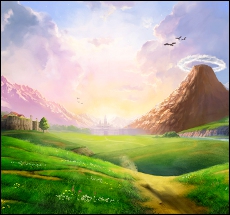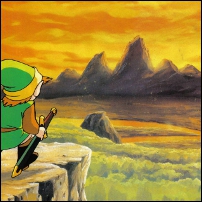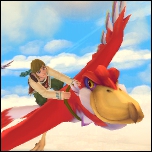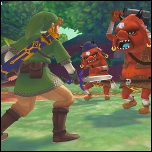Overworlds: The Land Between
Posted on August 05 2011 by Axle D. Wilder
 Overworld. This is a common video game term used when discussing adventure titles and RPGs, and as such it is frequently used in Zelda discussions. Wiktionary defines “overworld” as:
Overworld. This is a common video game term used when discussing adventure titles and RPGs, and as such it is frequently used in Zelda discussions. Wiktionary defines “overworld” as:
So by definition, any area that cannot be classed as one of the “safe areas” (towns) or the dangerous caves, tunnels and fortresses through which you battle (dungeons, levels) is considered the overworld. The overworld is a natural aspect of any video game which emphasized exploration or travel. This is the region you pass through on your mission or adventure between various unique destinations. In an adventure title like Zelda, overworlds are especially important and integral aspects of the game. By definition, in an adventure title you are adventuring! You’re exploring, wandering, finding your way, and seeking something or anything. While in many cases Zelda fans (including myself) measure the games by how many dungeons they contain or how many sidequests there are, the overworld is an equally important section of the gameplay. It might even be more important than dungeons, since ultimately you are going to spend more time traveling between destinations than you will within them. I think that many gamers, at least subconsciously, write off overworlds as the filler areas between a game’s real content. Even I am guilty of this, and while I think that can be true of other genres, I do not think it applies here with Zelda and adventure games in general. The land between is, in fact, pivotal.
But the term “overworld” only applies to the role of the area, not what it actually contains or how it truly functions when you’re within it. There are many forms of overworlds across the video game industry. Let’s briefly go over the different types we’ve seen within the series.
First off, we have what I would call the wilderness, if I had to choose a term. This is probably, generally speaking, the most common form of overworld. Macmillan Dictionary defines “wilderness” as:
So according to this, we would define a wilderness overworld as a relatively empty stretch of land that is wild and dangerous. It is a place where you are left to your own devices. You must find your way, whether using a map or your own wit. The land itself is wild, and may present a variety of challenges, including enemies or the terrain itself as you traverse it. These overworlds are usually not simple or basic in design and may resemble mazes, fields, or other sorts of areas depending on the section of the overworld you find yourself in. The original Legend of Zelda, as well as A Link to the Past, Link’s Awakening, Oracle of Ages, Oracle of Seasons, The Minish Cap, and Twilight Princess (arguably), have all had wilderness overworlds.
Next is the map. Strictly speaking, this overworld is not fully realized but is actually a representation of the world that you are traversing. Many Japanese RPGs use some form of this, and depending on the game the map might be little more than a menu screen, or a dumbed down and representational version of the world itself. The only main Zelda game to truly use this is Adventure of Link, in that the overworld only represents the world and that all true gameplay is contained within the towns, caves and dungeons, as well as the battle screens that appear upon colliding with enemies.

Then we have the hub. In this version of an overworld, you have a central region that, usually at its edges, allows you access to the game’s other areas. Strictly speaking, some of those areas may still be considered elements of the overworld, but even so the hub setup is distinct in that these areas chiefly surround and are connected by the hub area. Both Ocarina of Time and Majora’s Mask utilize this overworld, and additionally Twilight Princess can arguably be classified under this as well. TP’s overworld somewhat defies definition, in that it has elements of a hub while also making the overworld more wild and complex, so it has elements that fall under both a wilderness and a hub.
Finally, we have transportation, which in some ways borrows elements from a map. In this, the overworld cannot simply be traversed like the towns and dungeons can. For one reason or another, the overworld requires an alternate method of transportation to cross, most of the time resulting in a totally different form of gameplay than the rest of the game as you travel to your destination. The Wind Waker was the first Zelda game to have a transportation overworld, and its sequels Phantom Hourglass and Spirit Tracks have as well.
 Now I could talk for a while about the pros and cons of each individual variation of overworld, but I think that in relation to Zelda it’s a pretty simple issue. Barring occasional experimentational titles, spinoffs, side-games and special sub-series (like OoX or TWW, PH and ST), the overworlds in Zelda games should be designed in such a way as to befit the series’ genre, which is adventure. In this light, I think the wilderness variety of overworld is distinctly superior in concept, while all other varieties have their own ways of detracting from the adventure. Maps dumb down the area and let you interact with it less, hubs are a single area you must constantly return to in order to go anywhere or do anything, and transportation prevents you from truly experiencing any kind of adventure as you essentially play a minigame while you wait to arrive at your destination. All types have their merits, of course, and certainly aren’t offensive in the context of merely being one game or even a handful. Additionally, elements of two or more of these overworlds can be combined, but I still maintain that the core aspects of a wilderness are the most natural to the adventure genre, and most beneficial to it, because they encourage exactly what defines the genre. Adventure, exploration, danger, intrigue.
Now I could talk for a while about the pros and cons of each individual variation of overworld, but I think that in relation to Zelda it’s a pretty simple issue. Barring occasional experimentational titles, spinoffs, side-games and special sub-series (like OoX or TWW, PH and ST), the overworlds in Zelda games should be designed in such a way as to befit the series’ genre, which is adventure. In this light, I think the wilderness variety of overworld is distinctly superior in concept, while all other varieties have their own ways of detracting from the adventure. Maps dumb down the area and let you interact with it less, hubs are a single area you must constantly return to in order to go anywhere or do anything, and transportation prevents you from truly experiencing any kind of adventure as you essentially play a minigame while you wait to arrive at your destination. All types have their merits, of course, and certainly aren’t offensive in the context of merely being one game or even a handful. Additionally, elements of two or more of these overworlds can be combined, but I still maintain that the core aspects of a wilderness are the most natural to the adventure genre, and most beneficial to it, because they encourage exactly what defines the genre. Adventure, exploration, danger, intrigue.
But regardless of the type of overworld design in question, I maintain what I said at the beginning of this article: because of their prominent role in gameplay, overworlds cannot be lacking. You will always have to return to it, hunt for items and secrets within it, or otherwise constantly interact with it. It must have an immense amount of work put into it, and there is no excuse to do otherwise.
And finally, this brings us to Skyward Sword. Being a game that has not yet come out, we are not yet certain about all aspects of its overworld. We know that you will fly around in a sky overworld on the back of a Loftbird, hopping off onto floating islands and also diving down to the surface. This is a textbook description of a transportation overworld. That said, there may be more to it.
What exactly will the surface be like? We already know there will be lengthy sections of the game played on-foot but not within the dungeons or towns, so we do have sections of overworld similar at least to the islands in The Wind Waker. What I find particularly curious, however, is that Nintendo has already confirmed that to be the case in the sky overworld above. We are supposed to be able to find floating islands that we can hop onto and explore. So if that’s the case, then why would the surface sections be separated like islands as well? I don’t think they would be, and I certainly don’t think that they should be.

 I expect what many have been speculating on for a while, which is dual overworlds. There will be a transportation overworld in the sky above, and a wilderness on the surface below. It is likely that sections of the surface will only be accessible initially from the sky, but they will quickly connect to the other regions and become a fully realized and enthralling overworld. Depending on how this is implemented, it will have the added benefit of the transportation overworld above being very quick, allowing it to function as fast transit resembling warping, allowing you to quickly reach other areas of the wilderness below. The floating islands will serve as small, entertaining sections of traversible land, with the occasional town or even dungeon, whereas the land below will be one single, expansive land to adventure across.
I expect what many have been speculating on for a while, which is dual overworlds. There will be a transportation overworld in the sky above, and a wilderness on the surface below. It is likely that sections of the surface will only be accessible initially from the sky, but they will quickly connect to the other regions and become a fully realized and enthralling overworld. Depending on how this is implemented, it will have the added benefit of the transportation overworld above being very quick, allowing it to function as fast transit resembling warping, allowing you to quickly reach other areas of the wilderness below. The floating islands will serve as small, entertaining sections of traversible land, with the occasional town or even dungeon, whereas the land below will be one single, expansive land to adventure across.
There is some chance that I am mistaken, and the surface will be divided into sections that really only serve as more islands or destinations for yet another transportation game. As fun as the transportation can be from time to time, I maintain that it detracts from the raw adventure of the title in most cases, either in small or large part. If Skyward Sword carries this trend over from Phantom Hourglass and Spirit Tracks, it will likely be a somewhat disappointing overworld that won’t be as good as it could have been. That said, I really do not believe this to be the case, and I stand by my prediction on the matter.
One other curious note is the fact that it’s strongly implied that we will constantly return to Skyloft, Link’s hometown, and use its shops and other services while interacting with the people there. If this is true, then the game also incorporates some mild elements of a hub, even if it’s in a town and not the overworld itself, which strengthens my previous statements about Skyward Sword being a combination of major traits from a variety of Zelda games and also supports my previous statement that the types of overworlds can be combined successfully. Hopefully, with the elements of hubs and transportation added in, Nintendo will not hold back in giving us a grand wilderness to explore and battle across.
You may disagree with my statements about what elements of the various types are better or worse, and if so I encourage you to leave a comment below or post on the forums and start a discussion. Nonetheless, I think we can reach a common point of agreement in that the overworld is a significant element of game design in a series such as Zelda and should not be considered secondary in any sense, but rather an equal to other aspects of the game. We can glean from information revealed about Skyward Sword and statements by the developers that Nintendo is taking the overworld seriously, and regardless of what it actually winds up being we can at least take comfort in that. With this article in mind, please tell me what you think about overworlds, their nature, their role in Zelda, adventure games, and gaming in general, and your thoughts about the best overworlds and their future role in Zelda.



